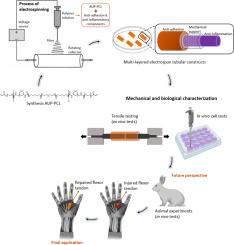Biomaterials Advances ( IF 5.5 ) Pub Date : 2020-09-11 , DOI: 10.1016/j.msec.2020.111504 Nele Pien , Ian Peeters , Liesbet Deconinck , Lana Van Damme , Lieven De Wilde , Ann Martens , Sandra Van Vlierberghe , Peter Dubruel , Arn Mignon

|
This research aims at developing a more potent solution for deep flexor tendon repair by combining a mechanical and biological approach. A reinforced, multi-layered electrospun tubular construct is developed, composed of three layers: an inner electrospun layer containing an anti-inflammatory component (Naproxen), a middle layer of braided monofilament as reinforcement and an outer electrospun layer containing an anti-adhesion component (hyaluronic acid, HA). In a first step, a novel acrylate endcapped urethane-based precursor (AUP) is developed and characterized by measuring molar mass, acrylate content and thermo-stability. The AUP material is benchmarked against commercially available poly(ε-caprolactone) (PCL). Next, the materials are processed into multi-layered, tubular constructs with bio-active components (Naproxen and HA) using electrospinning. In vitro assays using human fibroblasts show that incorporation of the bio-active components is successful and not-cytotoxic. Moreover, tensile testing using ex vivo sheep tendons prove that the developed multi-layered constructs fulfill the required strength for tendon repair (i.e. 2.79–3.98 MPa), with an ultimate strength of 8.56 ± 1.92 MPa and 8.36 ± 0.57 MPa for PCL and AUP/PCL constructs respectively. In conclusion, by combining a mechanical approach (improved mechanical properties) with the incorporation of bio-active compounds (biological approach), this solution shows its potential for application in deep flexor tendon repair.
中文翻译:

设计和开发用于修复深屈肌腱断裂的增强型管状电纺结构
这项研究旨在通过结合机械和生物学方法,为深屈肌腱修复开发更有效的解决方案。开发了一种增强的多层电纺管状结构,该结构由三层组成:包含抗炎成分(萘普生)的内层电纺层,作为增强层的编织单丝中间层和包含抗粘连成分的外层电纺层(透明质酸,HA)。第一步,开发了一种新型的丙烯酸酯封端的氨基甲酸酯基前体(AUP),并通过测量摩尔质量,丙烯酸酯含量和热稳定性进行了表征。AUP材料以市售的聚(ε-己内酯)(PCL)为基准。接下来,将材料加工成多层,使用静电纺丝的具有生物活性成分(萘普生和HA)的管状结构。使用人成纤维细胞的体外测定表明,生物活性成分的掺入是成功的,并且没有细胞毒性。此外,使用离体绵羊肌腱的拉伸测试证明,开发的多层结构可满足肌腱修复所需的强度(即2.79–3.98 MPa),PCL和AUP的极限强度为8.56±1.92 MPa和8.36±0.57 MPa。 / PCL构造。总之,通过结合机械方法(改善的机械性能)和掺入生物活性化合物(生物方法),该解决方案显示了其在深屈肌腱修复中的应用潜力。使用人成纤维细胞的体外测定表明,生物活性成分的掺入是成功的,并且没有细胞毒性。此外,使用离体绵羊肌腱的拉伸试验证明,开发的多层结构可满足肌腱修复所需的强度(即2.79–3.98 MPa),PCL和AUP的极限强度为8.56±1.92 MPa和8.36±0.57 MPa。 / PCL构造。总之,通过结合机械方法(改善的机械性能)和掺入生物活性化合物(生物方法),该解决方案显示了其在深屈肌腱修复中的应用潜力。使用人成纤维细胞的体外测定表明,生物活性成分的掺入是成功的,并且没有细胞毒性。此外,使用离体绵羊肌腱的拉伸测试证明,开发的多层结构可满足肌腱修复所需的强度(即2.79–3.98 MPa),PCL和AUP的极限强度为8.56±1.92 MPa和8.36±0.57 MPa。 / PCL构造。总之,通过结合机械方法(改善的机械性能)和掺入生物活性化合物(生物方法),该解决方案显示了其在深屈肌腱修复中的应用潜力。对于PCL和AUP / PCL结构,分别为92 MPa和8.36±0.57 MPa。总之,通过结合机械方法(改善的机械性能)和掺入生物活性化合物(生物方法),该解决方案显示了其在深屈肌腱修复中的应用潜力。对于PCL和AUP / PCL结构,分别为92 MPa和8.36±0.57 MPa。总之,通过结合机械方法(改善的机械性能)和掺入生物活性化合物(生物方法),该解决方案显示了其在深屈肌腱修复中的应用潜力。











































 京公网安备 11010802027423号
京公网安备 11010802027423号